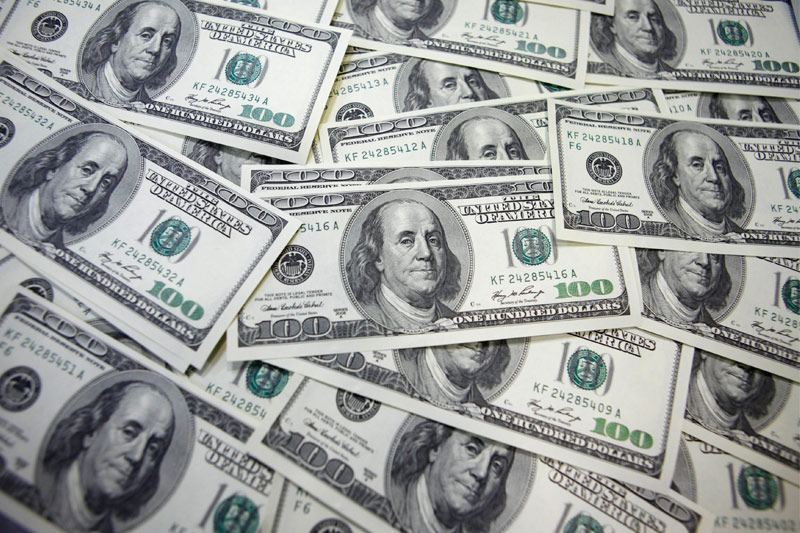Investing.com - The dollar fell to session lows against the euro on Wednesday after unexpectedly strong German industrial output data tempered expectations for further rate cuts by the European Central Bank.
During U.S. morning trade, the dollar hit session lows against the euro, with EUR/USD advancing 0.79% to 1.3181.
Official data showed that German industrial output jumped 1.2% in March, the largest increase in 12 months and confounding expectations for a 0.1% decline.
The data came one day after a report showed that German factory orders also beat expectations in March, rising 2.2%, the fastest rate of growth since October 2012.
The data fuelled optimism over the outlook for first quarter growth after Germany’s economy contracted by 0.5% in the three months to December and tempered rate cut expectations.
Speculation over the possibility of further rate cuts by the ECB intensified after President Mario Draghi said Monday that the bank would monitor all euro zone data over the coming weeks and was ready to act if needed.
The dollar slid lower against the yen, with USD/JPY down 0.23% to 98.76.
The dollar was lower against the pound and the Swiss franc, with GBP/USD rising 0.54% to 1.5567 and USD/CHF shedding 0.52% to trade at 0.9352.
The Swiss franc showed little reaction after official data showed that consumer prices in Switzerland fell 0.6% from a year earlier in April, compared to expectations for a 0.5% decline.
The greenback was mixed against its Australian, New Zealand and Canadian counterparts, with AUD/USD edging up 0.04% to 1.0188, NZD/USD dropping 0.74% to 0.8393 and USD/CAD sliding 0.13% to 1.0029.
The Australian dollar firmed up following better-than-expected Chinese trade data, after falling sharply on Tuesday when the Reserve Bank of Australia cut rates to a record low 2.75%.
Official data showed that Chinese imports and exports rose more than expected in April, easing concerns over a slowdown in the world’s second largest economy.
The New Zealand dollar remained under broad selling pressure after Reserve Bank of New Zealand Governor Graeme Wheeler said the bank had intervened in markets to try to stem the appreciation of the currency.
In Canada, data showed that building starts fell in line with expectations in April, dropping to 174,900 units from 181,100 units in March.
The dollar index, which tracks the performance of the greenback versus a basket of six other major currencies, was down 0.59% to 81.87.
During U.S. morning trade, the dollar hit session lows against the euro, with EUR/USD advancing 0.79% to 1.3181.
Official data showed that German industrial output jumped 1.2% in March, the largest increase in 12 months and confounding expectations for a 0.1% decline.
The data came one day after a report showed that German factory orders also beat expectations in March, rising 2.2%, the fastest rate of growth since October 2012.
The data fuelled optimism over the outlook for first quarter growth after Germany’s economy contracted by 0.5% in the three months to December and tempered rate cut expectations.
Speculation over the possibility of further rate cuts by the ECB intensified after President Mario Draghi said Monday that the bank would monitor all euro zone data over the coming weeks and was ready to act if needed.
The dollar slid lower against the yen, with USD/JPY down 0.23% to 98.76.
The dollar was lower against the pound and the Swiss franc, with GBP/USD rising 0.54% to 1.5567 and USD/CHF shedding 0.52% to trade at 0.9352.
The Swiss franc showed little reaction after official data showed that consumer prices in Switzerland fell 0.6% from a year earlier in April, compared to expectations for a 0.5% decline.
The greenback was mixed against its Australian, New Zealand and Canadian counterparts, with AUD/USD edging up 0.04% to 1.0188, NZD/USD dropping 0.74% to 0.8393 and USD/CAD sliding 0.13% to 1.0029.
The Australian dollar firmed up following better-than-expected Chinese trade data, after falling sharply on Tuesday when the Reserve Bank of Australia cut rates to a record low 2.75%.
Official data showed that Chinese imports and exports rose more than expected in April, easing concerns over a slowdown in the world’s second largest economy.
The New Zealand dollar remained under broad selling pressure after Reserve Bank of New Zealand Governor Graeme Wheeler said the bank had intervened in markets to try to stem the appreciation of the currency.
In Canada, data showed that building starts fell in line with expectations in April, dropping to 174,900 units from 181,100 units in March.
The dollar index, which tracks the performance of the greenback versus a basket of six other major currencies, was down 0.59% to 81.87.
